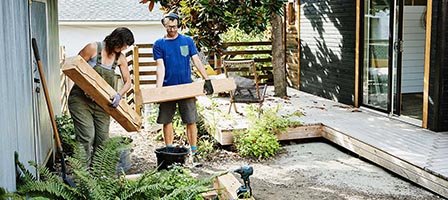Maximize Your Tax Savings: The Importance of Keeping Home Improvement Records Before Selling Your Home

Article Highlights:
- Keeping home improvement records
- Home gain exclusion amounts
- Records may be required to avoid tax
Many taxpayers don’t feel the need to keep home improvement records, thinking the potential gain when they sell their home will never exceed the amount of the tax code’s exclusion for home gains explained as follows.
Under the current version of the tax code, you are allowed to exclude from your income up to $250,000 ($500,000 for married couples) of gain from the sale of your primary residence if you owned and lived in it for at least 2 years (24 months) of the 5 years before the sale. You also cannot have previously taken a home-sale exclusion within the 2 years immediately preceding the sale. There is no limit on the number of times you can use the exclusion if you meet these time requirements; however, extenuating circumstances can reduce the amount of the exclusion. The home-sale gain exclusion only applies to your main home, not to a second home or a rental property.
As noted above, you must have used and owned the home for 2 out of the 5 years immediately preceding the sale. The years don’t have to be consecutive or the closest to the sale date. Vacations, short absences, and short rental periods do not reduce the use period. If you are married, to qualify for the $500,000 exclusion, both you and your spouse must have used the home for 2 out of the 5 years prior to the sale, but only one of you needs to meet the ownership requirement. When only one spouse in a married couple qualifies, the maximum exclusion is limited to $250,000 instead of $500,000.
If you don’t meet the ownership and use requirements, there are some situations in which a prorated exclusion amount may be possible. An example of this situation would be if you were required to sell the home because of extenuating circumstances, such as a job-related move, a health crisis or other unforeseen events. Another rule extends the 5-year period to account for the deployment of military members and certain other government employees. Please call this office if you have not met the 2 out of 5 rule to see if you qualify for a reduced exclusion.
But what if your home sale gain is more than the home sale exclusion? Then it is in your best interests to have kept home improvement records, since the costs of improvements can be added to your purchase price of the home to be used in determining the gain. So keeping the receipts for the improvements, even if only in a folder or a shoe box, may be useful in the future when you sell your home.
Here are some situations when having home improvement records could save taxes:
(1) The home is owned for a long period of time, and the combination of appreciation in value due to inflation and improvements exceeds the exclusion amount.
(2) The home is converted to a rental property, and the cost and improvements of the home are needed to establish the depreciable basis of the property.
(3) The home is converted to a second residence, and the exclusion might not apply to the sale.
(4) You suffer a casualty loss and retain the home after making repairs.
(5) The home is sold before meeting the 2-year use and ownership requirements.
(6) The home only qualifies for a reduced exclusion because the home is sold before meeting the 2-year use and ownership requirements.
(7) One spouse retains the home after a divorce and is only entitled to a $250,000 exclusion instead of the $500,000 exclusion available to married couples.
(8) There are future tax law changes that could affect the exclusion amounts.
Everyone hates to keep records but consider the consequences if you have a gain and a portion of it cannot be excluded. You will be hit with capital gains (CG), and there is a good chance the CG tax rate will be higher than normal simply because the gain pushed you into a higher CG tax bracket. Before deciding not to keep records, carefully consider the potential of having a gain more than the exclusion amount.
Home improvements include just about anything that will increase the value of the home, from big ticket items like remodeling a kitchen, adding another room or a swimming pool, and landscaping to smaller items like ceiling fans. But there are some home improvements that cannot be included in the cost of home improvements, or may be only partly included. Examples are items which qualify for tax credits such as home solar, home energy efficient improvements or those that qualify for a tax deduction such as handicap improvements. In addition, the costs of general maintenance or repairs, such as fixing leaks, painting (interior or exterior), and replacing broken hardware do not count as improvements.
If you have questions related to the home gain exclusion or questions about how keeping home improvement records might directly affect you, please give this office a call.
|
|  |





